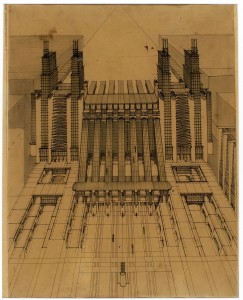‘Zeitgeist’ translates to ‘spirit of the age’. This concept of a ‘spirit’ of a certain time conveyed through art and architecture was widely embraced throughout the twentieth century. Multiple movements and individuals attempted to engage the ‘spirit’ of their times to create architecture suitable for their new values and representative of a changing society. One such architectural movement was the Futurist movement, a predominantly artistic movement that engaged with architectural ideas also. By looking at how the Futurists attempted to craft a new vision of Italy to bring their country into the twentieth century, and then at how these visions shifted after the First World War (1914-1918) when the Fascist Party came to power with Mussolini, we can trace the shifting Zeitgeist of early twentieth-century Italy and how it was translated by different architects.
Antonio Sant’Elia (1888-1916) was the driving force behind the Futurist architectural theory. His vision embraced the machine age; the Zeitgeist for the Futurists was dynamic and violent. In 1914, at a show for the Nuove Tendenze group, Sant’Elia ‘made the definitive statement’ of Futurist architecture through series of studies called ‘Citta Nuova’ and a published text.[1] This text was distributed as the ‘Manifesto of Futurist Architecture’ later that year, after modifications.
The new architecture, as conceived by the Futurists, centred around ‘the world of work, factories and machines.’[2] Sant’Elia began his manifesto rejecting historicism as something holding architects back from finding an architectural language truly expressive of their age, an idea influenced by the Vienna Secession. [3] The world was suddenly moving at a much faster rate, and in the Futurists’ minds this meant the evolution of architectural form was no longer a slow progression, but that the new materials of iron and concrete had galvanised them into changing their reality.[4] These materials should therefore be used to create architecture that would facilitate the new modern way of living.

With the changing needs of society, old typologies make way for new ones in Sant’Elia’s utopia.[5] The Citta Nuova project of 1914 exemplifies this idea of incorporating modern innovations like automobiles and air travel. His conceptions of this technology are very original and pioneering. In Figure 1 we see how Sant’Elia has provided an architecture that allows trains and aeroplanes to integrate into one station. The forms are monumental and stripped of ornamentation, taking on an industrial aesthetic. Sant’Elia was inconsistent in his attitude to monumentality, rejecting ‘static forms’ but as we see here, he embraces mass and imposing effects in his architecture for the new age.[6]
Post World War One in Italy, the architecture representing the age shifted in spirit. Giuseppe Terragni (1904-1943), a key architect of the period, embraced fascism as the basis for forming new society. He looked to the architectural heritage of Italy and translated it into a modern interpretation of values. Thomas Schumacher points out that ‘Mussolini had come to power four years before the Modern movement was “imported” from across the Alps, and by 1926-27 he had not only solidified his power but had begun to build a Fascist culture as well.’[7] Architecture of this period consequently had strong political motivations.

The Casa del Fascio (1932-36) [Fig.2] epitomises the spirit of the fascist age. In Terragni’s report ‘The Construction of the Casa del Fascio in Como’, published after the building was finished, we see his occupation with embodying the political situation. He asserts: “thus Mussolini’s concept of fascism as a glass house into which everyone can peer gives rise to this interpretation which is a continuation of the former: no obstacles, no barriers, nothing between the political leader and his people.”[8] Visibility is the key concept behind the construction of this party headquarters, transparency of government to serve the people. The building is stripped down, unadorned and clearly influenced by modernist architects like Le Corbusier, but it also references classical proportions and columns, and is clad in white marble, the traditional classical material.
From these two case studies it is possible to read how the Zeitgeist shifted in perception and realisation in architectural form in Italy. The spirit of the age remained an important inspiration for finding new architectural forms, and remained a motivating force throughout the century, notably in Britain in the 1970s with the High Tech movement.
[1] Claudia Salaris, ‘The Invention of the Programmatic Avant-Garde’ in Italian Futurism 1909-1944 : reconstructing the universe, ed. Vivien Greene (New York : Guggenheim Museum Publications, 2014), 34.
[2] Salaris, ‘The Invention of the Programmatic Avant-Garde’, 35.
[3] Esther Da Costa Meyer, ‘Drawn into the Future: Urban Visions by Mario Chiattone and Antonio Sant’Elia’ in Italian Futurism 1909-1944 : reconstructing the universe, ed. Vivien Greene (New York : Guggenheim Museum Publications, 2014), 141.
[4] Esther Da Costa Meyer, The Work of Sant’Elia: Retreat into the Future (New Haven : Yale University Press, 1995), 142.
[5] Da Costa Meyer, ‘Drawn into the Future’, 141.
[6] Da Costa Meyer, The Work of Sant’Elia, 144.
[7] Thomas L. Schumacher, Surface & symbol : Giuseppe Terragni and the architecture of Italian rationalism (New York : Princeton Architectural Press, 1991) 23.
[8] Schumacher, Surface & symbol, 143.
